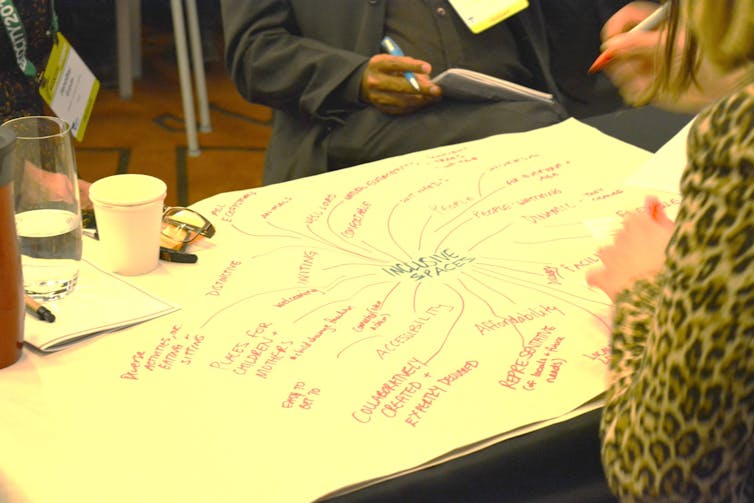Putting the pieces together to create safe public spaces for all
GUEST OBSERVER
Green and public spaces must be safe, inclusive and accessible for all. In Australia, however, most young women do not feel safe in public spaces, especially after dark or when walking alone. Welcoming public spaces are also in decline in the US.
Calls to enhance the built environment for the benefit and well-being of half of humanity, the 3.5 billion people living in cities today, have never been so strong, especially since Habitat III.
Universal access to safe and inclusive public spaces is a key target of Sustainable Development Goal 11. A follow-up placemaking training event at the ninth World Urban Forum (WUF9), starting this week in Kuala Lumpur, Malaysia, will continue this global discussion on co-creating inclusive public spaces.
Yet improving public space requires significant investment. To ensure that city governments, private developers and citizen experts continue to make meaningful investments in creating better public parks, playgrounds, streets and sidewalks, we need to be able to assess the public value of such spaces.
So what are the ingredients of success?
For a public space to be seen as safe, comfortable and successful, a diverse range of people need to actively use it. In a workshop at the 2017 EcoCity World Summit in Melbourne, experts discussed challenges in everyday practices of developing and maintaining inclusive public spaces. The discussions led to a common understanding of what these spaces look like.
A workshop at the EcoCity World Summit in Melbourne. Author provided
Several key elements of successful public space were identified:
Public space should not favour specific groups or promote gentrification. Sometimes, architectural design of public spaces can restrict the free use of space.
Inclusive spaces work by encouraging a diverse mix of people who feel safe and comfortable in them. This mix should be intergenerational as well as intercultural.
Inclusive spaces can thrive only when they are open, free and accessible. The space should allow some flexibility in its use to suit changing needs. When streets and plazas accommodate multiple activities, they are activated at all times, even if used differently at different times.
Inclusive spaces must respect and acknowledge the needs of all genders and recognise children as active users of space. World Vision International, for instance, engages children as change agents who inform planning decisions for better and safer spaces.
Public space is accessible when it is well integrated and connected with surrounding land uses and transport options. If we design for people rather than cars, we can create places that more people are able to access and use.
Inclusion depends on real participation
Participatory processes are incomplete without integrating community voice, building place-based relationships, fostering a sense of belonging and encouraging open communication in communities.
To achieve long-term success, it is important to understand how citizens can contribute to creating more inclusive spaces. Any space-changing project needs to nurture community and foster a sense of belonging among neighbouring residents.
Co-designing with the local community is crucial for a space to have a long-term sustainable impact and maintain continuous engagement. In Hobart’s Macquarie Point, for example, in addition to successfully building partnerships between multiple stakeholders, the project applied a phased activation plan, to allow the community to slowly engage with the spaces.
People have different ways of voicing their opinions. These different means of expression and participation need to be recognised when designing an inclusive space. Storytelling is one powerful tool to share and listen to local histories of place. It helps create meaningful city spaces that are valuable to the whole community.
Technology promises new and innovative ways of engaging communities. Crowdsourcing is one approach to tap into the community and encourage them to share their experience in their use of public space.
Plan International’s map-based community engagement tool allowed women to chart safe and unsafe spaces in the city and comment on them. This was an effective way for women with similar experiences to come together virtually and volunteer information.
However, easy translation of data into usable information to be shared widely is equally important for any participatory exercise.
Many elements go into creating an inclusive public space. Author provided
Evaluating success of public spaces
Workshop participants found it particularly challenging to find the most effective means to measure the success of public spaces. Few appraisal tools exist to measure the quality of public space.
The project evaluation component almost always falls by the wayside as the impact of public spaces takes longer to manifest but is crucial to sustaining these spaces.
The workshop discussion highlighted the need to further explore evaluation tools that help ensure projects and initiatives have lasting outcomes.
The next steps
Public space is a critical ingredient of liveable cities. It is also recognised as important for sustainable urban development.
Getting it right requires investment in research, programming, information and advocacy.
![]() Health, well-being and prosperity all depend on the rightful use of public space to create communities that are inclusive and connected for the benefit of everyone.
Health, well-being and prosperity all depend on the rightful use of public space to create communities that are inclusive and connected for the benefit of everyone.
SriPallavi Nadimpalli, PhD Candidate, University of Melbourne
Iderlina Mateo-Babiano, Senior Lecturer in Urban Planning, University of Melbourne
Joyati Das, Associate, Melbourne Sustainable Society Institute, University of Melbourne
This article was originally published on The Conversation. Read the original article.


